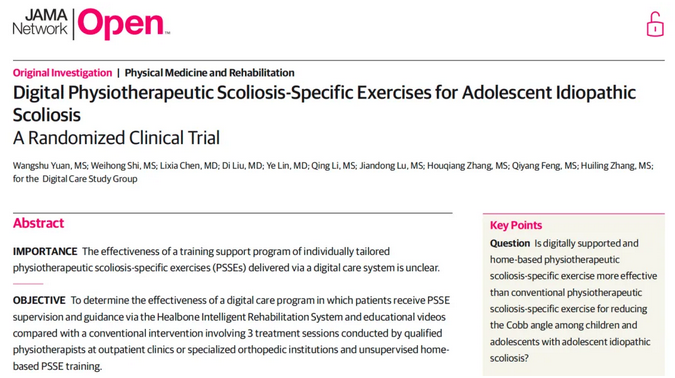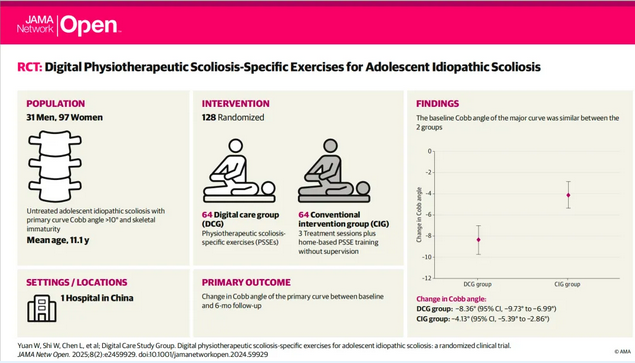On February 18, 2025, a research team led by Professor Chen Lixia, Director of the Department of Rehabilitation Medicine at PUMCH, published a single-center randomized controlled trial in JAMA Network Open (IF=10.5), a journal in the JAMA network. The study compared the effectiveness of physiotherapeutic scoliosis-specific exercise (PSSE) for patients with adolescent idiopathic scoliosis (AIS) under two models: one delivered via a digital care system and another receiving rehabilitation guidance at outpatient clinics followed by home-based training. The research demonstrated that AIS patients receiving PSSE training support via a digital care system showed significantly better improvement. This study was supported by the National High-Level Hospital Clinical Research Funding.

The prevalence of AIS ranges from 0.35% to 5.2%, with rapid progression during adolescence. PSSE is the first-line treatment for mild to moderate AIS patients. However, the scarcity of specialized therapists and facilities, and patients' time constraints and travel difficulties are all barriers to the implementation of professional PSSE training guidance programs. Additionally, due to various personal factors, some patients exhibit poor adherence to home-based PSSE training and incorrect exercise techniques, leading to suboptimal outcomes from home-based PSSE training.

To address these issues, the Department of Rehabilitation Medicine at PUMCH initiated a single-center randomized controlled trial on June 1, 2023. The study included 128 AIS patients with an average age of 11.2 years. Using the PUMCH-SSE classification for conservative treatment, patients were categorized into different subtypes, and personalized PSSE training programs were designed for each subtype.
All patients were randomly divided into two groups and underwent PSSE training for six months. Patients in the experimental group received one PSSE training session at the outpatient clinic along with guidance on using the digital care system, after which they completed six months of digitally supported, home-based PSSE training. Patients in the control group received one PSSE training session per month at the outpatient clinic during the first three months while conducting unsupervised home-based PSSE training lasting six months. Researchers evaluated changes in the spinal curvature measurement (Cobb angle) before training and after six months of intervention.
The study found that after six months of intervention, patients in the experimental group showed significantly greater improvement in Cobb angle compared to the control group. The experimental group also demonstrated better improvement in pelvic coronal plane tilt angle during gait analysis. The results indicated that AIS patients receiving PSSE training supported by the digital care system recovered better.
Professor Chen Lixia explained that compared to the conventional rehabilitation model, patients using the digitally supported rehabilitation system could flexibly schedule their rehabilitation training, significantly reducing time and travel costs while improving treatment adherence. Furthermore, the digital care model allows more patients to access professional rehabilitation services. Currently, Professor Chen's research team is conducting studies on digitally supported rehabilitation across multiple rehabilitation subspecialties.
Written by the Department of Rehabilitation Medicine and the Publicity Department
